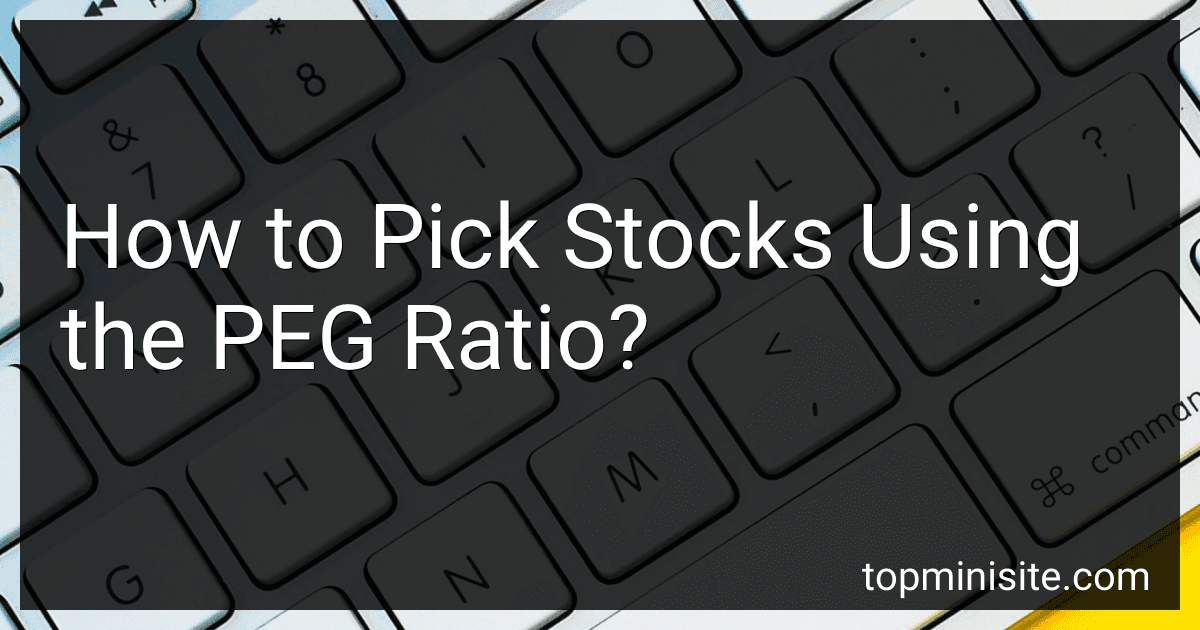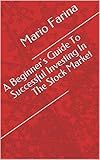Best PEG Ratio Books to Buy in December 2025
The PEG ratio is a financial metric that investors often use to evaluate the potential value of a stock. It stands for Price/Earnings to Growth ratio. It's a more comprehensive ratio than just the price-to-earnings (P/E) ratio as it takes into account the company's expected future earnings growth.
To pick stocks using the PEG ratio, you would typically follow these steps:
- Identify Potential Stocks: Begin by researching and analyzing companies you are interested in investing in. Look for companies that have a history of consistent earnings growth and show potential for future growth.
- Calculate the P/E Ratio: Determine the current P/E ratio for each stock you are considering by dividing the stock's current market price by its earnings per share (EPS). This ratio gives you an idea of how much investors are willing to pay for each dollar of earnings.
- Estimate the Earnings Growth Rate: Assess the expected earnings growth rate for the company. You can find this information by researching analyst reports, financial websites, or reviewing the company's historical earnings growth. This estimation should cover a relevant time period, such as the next five years.
- Calculate the PEG Ratio: Divide the P/E ratio by the estimated earnings growth rate. The resulting figure is the PEG ratio. The PEG ratio indicates whether the stock may be undervalued or overvalued based on its earnings and growth potential.
- Interpret the PEG Ratio: Generally, a PEG ratio of 1 or less suggests that the stock may be undervalued. A ratio above 1 might indicate an overvalued stock. However, it is essential to consider other factors and compare the PEG ratio with industry averages to gain a more accurate understanding of the stock's value.
- Make an Informed Decision: After considering the PEG ratio, delve deeper into the company's fundamentals, such as its financial health, competitive positioning, industry trends, and any potential risks. Evaluate the stock comprehensively to make an informed investment decision.
It's crucial to note that the PEG ratio is not the only factor to consider when making investment decisions. Complement your analysis with other fundamental and technical indicators, while also considering your investment objectives, risk tolerance, and diversification strategies. Consulting with a financial advisor or professional is also recommended to ensure an informed approach to stock picking using the PEG ratio or any other metrics.
What is the optimal PEG ratio for growth stocks?
The optimal PEG (Price/Earnings to Growth) ratio for growth stocks generally varies depending on the industry and market conditions. However, in general terms, a PEG ratio below 1.0 is considered favorable for growth stocks. This indicates that the stock's price is relatively low compared to its expected future earnings growth.
A PEG ratio of 1.0 suggests that the stock is fairly valued based on its projected growth rate, while a ratio above 1.0 indicates that the stock may be overvalued. However, determining the optimal PEG ratio requires thorough analysis of various factors including the company's competitive position, growth prospects, industry conditions, and overall market trends.
How to determine if a stock's PEG ratio is sustainable in the long run?
Determining if a stock's PEG ratio is sustainable in the long run requires analyzing various factors that influence the company's growth prospects. Here are some steps to consider:
- Understand the PEG ratio: The PEG ratio measures the price-to-earnings ratio (P/E ratio) of a stock relative to its expected earnings growth rate. A PEG ratio below 1 typically suggests a stock is undervalued based on its growth prospects, while a ratio above 1 may indicate overvaluation.
- Evaluate historical performance: Analyze the company's historical revenue and earnings growth rates over the past several years. Look for consistent growth patterns, as sustainable growth often depends on a track record of increasing profits.
- Industry analysis: Examine the company's industry to assess long-term growth potential. Factors such as market demand, competitive landscape, and technological advancements can impact the company's ability to sustain growth over time.
- Competitive advantage: Determine if the company holds a competitive advantage, such as unique products/services, strong brand recognition, or proprietary technology. A sustainable competitive advantage can support long-term growth.
- Market trends: Consider broader economic and market trends that may affect the company's growth potential. Assess factors such as demographic shifts, changing consumer preferences, or regulatory changes that could impact the company's industry.
- Management and strategy: Evaluate the company's management team's track record, experience, and strategic initiatives. A strong management team with a history of successful execution can contribute to sustainable growth.
- Fundamental analysis: Conduct a thorough fundamental analysis by examining the company's financial statements, including revenue, earnings, cash flow, and debt levels. This analysis will help assess if the company's growth is supported by strong financial metrics.
- Future growth catalysts: Identify potential growth drivers that can fuel the company's earnings in the future. This may include new product launches, expanding into new markets, or acquisitions.
- Risks and uncertainties: Consider any risks or uncertainties that could impact the company's growth prospects, such as regulatory changes, geopolitical events, or competitive threats.
By evaluating these factors, you can gain a better understanding of whether a stock's PEG ratio is sustainable in the long run. However, it's important to remember that assessing sustainability is subjective and that market conditions and company-specific factors can change over time.
What is the PEG ratio and how does it help in stock selection?
The Price/Earnings to Growth (PEG) Ratio is a valuation metric that helps investors assess the value of a stock relative to its expected future earnings growth. It incorporates both the price-to-earnings (P/E) ratio and the company's projected earnings growth rate.
The PEG ratio is calculated by dividing the P/E ratio by the company's earnings growth rate. It offers a more comprehensive analysis than just the P/E ratio, as it considers the stock's value in relation to its growth potential.
The PEG ratio helps in stock selection as it allows investors to identify stocks that may be undervalued or overvalued based on their growth prospects. A PEG ratio below 1 suggests that the stock may be undervalued, indicating that the market may not be fully pricing in its growth potential. Conversely, a PEG ratio above 1 indicates that the stock may be overvalued, as its expected growth rate is not justified by its current valuation.
However, the PEG ratio should not be relied upon as the sole factor in stock selection. It is important to consider other fundamental and technical analysis factors, along with the company’s industry position, competitive advantages, financial health, and market conditions, when making investment decisions.
How to evaluate a stock's potential return using the PEG ratio?
To evaluate a stock's potential return using the PEG (Price/Earnings to Growth) ratio, follow these steps:
- Calculate the PEG ratio: The PEG ratio is calculated by dividing the Price-to-Earnings (P/E) ratio of a company by its expected growth rate. The P/E ratio represents the current stock price divided by earnings per share (EPS), while the growth rate is the projected annual earnings growth for the company. PEG Ratio = P/E ratio / Expected Growth Rate
- Assess the P/E ratio: The P/E ratio reflects the market's perception of a company's earnings potential. A higher P/E ratio indicates the market expects higher growth, making the stock potentially overvalued, while a lower P/E ratio suggests undervaluation or lower growth expectations. Compare the P/E ratio of the stock in question to similar companies or the industry average to get a relative perspective.
- Determine the expected growth rate: The growth rate is typically provided by financial analysts or can be calculated based on historical growth rates and future projections. Ensure that the expected growth rate aligns with the company's business model, industry trends, competitive landscape, and potential catalysts that may impact growth.
- Evaluate the PEG ratio: Ideally, a stock with a PEG ratio closer to 1 is considered reasonably valued, implying the market is recognizing the stock's growth potential. A PEG ratio below 1 may indicate an undervalued stock with potential for higher returns, while a ratio higher than 1 might suggest an overvalued stock with potentially lower returns.
- Consider other factors: While the PEG ratio provides insight into a stock's potential return, it should not be the sole determinant. Assess additional factors like company fundamentals (financial health, profitability, competitive advantage), industry trends, market conditions, management team, and any specific risks associated with the company. Additionally, compare the PEG ratio with other valuation metrics like price-to-sales (P/S) ratio, price-to-book (P/B) ratio, or dividend yield for a comprehensive analysis.
- Regularly review and update: As financial information, growth projections, and market conditions change, it is essential to review and update your analysis regularly to ensure a current understanding of the stock's potential return using the PEG ratio. Remember that the PEG ratio is just one tool, and it is wise to consider a combination of valuation metrics and qualitative factors for a holistic assessment.
What is the relationship between a stock's PEG ratio and its valuation?
The relationship between a stock's PEG (Price/Earnings to Growth) ratio and its valuation is that the PEG ratio is used to assess the valuation of a stock relative to its growth prospects.
The PEG ratio is calculated by dividing a stock's Price/Earnings (P/E) ratio by its earnings growth rate. A PEG ratio below 1 is generally considered undervalued, while a ratio above 1 is considered overvalued. The lower the PEG ratio, the more attractive the stock is considered in terms of valuation, as it indicates that the stock's price is relatively low compared to its projected earnings growth.
Investors use the PEG ratio to evaluate the perceived value of a stock by considering its earnings growth potential. If a stock has a high P/E ratio but also has a high growth rate, it may still be considered attractive if its PEG ratio is low. Conversely, a stock with a low P/E ratio but a low growth rate may not be as appealing if its PEG ratio is relatively high.
However, it is important to note that the PEG ratio is just one of many valuation metrics, and it should not be solely relied upon to make investment decisions. Other factors, such as industry trends, competitive landscape, financial health, and market conditions, should also be considered in conjunction with the PEG ratio to have a comprehensive understanding of a stock's valuation.




